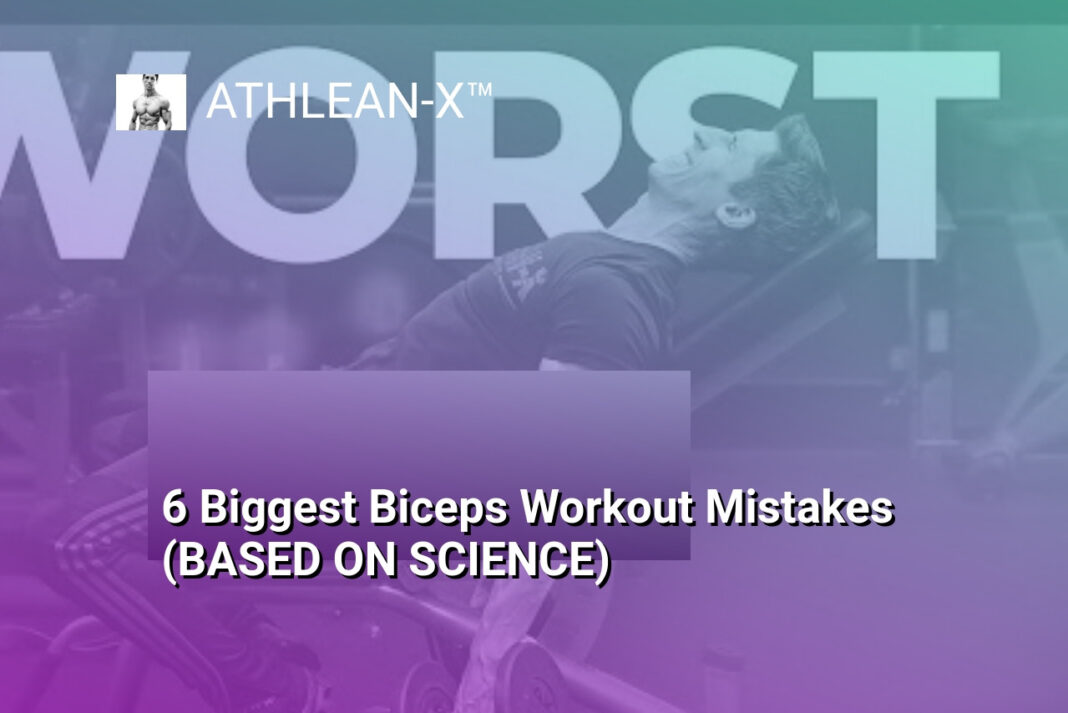The Bottom Line:
- The video discusses the common mistakes people make when training their biceps, and provides tips to improve the effectiveness of bicep exercises.
- The first mistake is not lifting the weight properly, as most people focus on just moving the weight from point A to point B, rather than controlling the movement and engaging the bicep muscles throughout the entire range of motion.
- The second mistake is not maintaining a straight wrist during bicep curls, as this can take some of the focus away from the bicep muscles and engage the forearm muscles instead.
- The third mistake is not varying the types of bicep exercises, as different exercises target the short head and long head of the bicep differently, and a variety of exercises is necessary for optimal bicep development.
- The fourth mistake is falling in love with a single “magic” exercise, as there is no one-size-fits-all exercise that is the best for everyone, and a variety of exercises is necessary for balanced bicep development.
Test Your Bicep Strength with This Simple Trick
Unlock the Secrets of Bicep Strength: A Simple Test
To gauge the effectiveness of your bicep training, try this simple test. Start by bending your elbow and squeezing your bicep as hard as you can. If you don’t feel any discomfort, try twisting your wrist outward slightly. If that still doesn’t elicit a cramping sensation, lift your elbow up to about shoulder height while maintaining the twisted wrist position.
The Importance of Wrist Positioning
The level of discomfort you experience during this test can reveal a lot about your bicep training. Allowing for wrist extension during bicep exercises can help take some of the focus off the forearms and place it squarely on the biceps. By carrying the weight in the middle portion of your palm rather than the fingertips, you’ll be able to perform more effective, biomechanically correct curls.
Targeting the Bicep Heads
It’s important to understand the different roles of the short and long heads of the biceps. The short head contributes to the width of the arm, while the long head is responsible for the peak. Exercises with your arms in front of you, like the no-money curl, tend to target the short head more, while exercises with your arms behind you, like the incline curl, focus more on the long head. Varying your exercise selection to target both heads can lead to more balanced, impressive bicep development.
Remember, it’s not about doing more sets, but rather about optimizing your technique and exercise selection to get the most out of your bicep training. Implement these strategies, and you’ll be well on your way to unlocking the secret to bigger, stronger biceps.
Slow Down Your Reps for Maximum Bicep Activation
Maximize Bicep Activation with Controlled Movements
One of the most effective ways to stimulate maximum bicep growth is to slow down your repetitions. Instead of rushing through the movements, focus on taking 4 seconds to lift the weight and another 4 seconds to lower it. This controlled tempo allows you to better recruit the bicep muscles and avoid relying on momentum or other muscle groups to complete the exercise.
The Importance of Wrist Position
Many people make the mistake of keeping their wrists rigid and straight during bicep curls. However, allowing a slight wrist extension can actually enhance the bicep contraction. As you curl the weight up, let your wrists extend naturally rather than forcing them to stay straight. This small adjustment can make a significant difference in the intensity of the bicep squeeze you feel.
Targeting the Bicep Heads
The biceps brachii muscle has two distinct heads – the short head and the long head. Targeting both heads is important for building well-rounded, aesthetically-pleasing biceps. Exercises that keep the arms in front of the body, like standard barbell curls, tend to emphasize the short head. Exercises that allow for shoulder extension, like incline dumbbell curls, better target the long head. Incorporating a variety of bicep exercises that address both heads will ensure balanced development.
The Importance of Wrist Position for Effective Bicep Curls
Optimizing Wrist Position for Maximizing Bicep Activation
The position of your wrists during bicep curls can have a significant impact on the effectiveness of the exercise and the overall development of your biceps. By understanding the importance of wrist position, you can unlock the true potential of your bicep training and achieve greater muscle growth.
The Biomechanics of Wrist Position
When performing bicep curls, the position of your wrists can either enhance or hinder the activation of the biceps. If you keep your wrists straight and your fingers pointing upwards, you’ll feel a stronger contraction in the biceps as you curl the weight up. This is because the extended wrist position helps to isolate the biceps and reduces the involvement of the forearm muscles.
On the other hand, if you allow your wrists to bend backward during the curl, you’ll start to feel more of a contraction in the forearm muscles, rather than the biceps. This can be a common mistake, as the tendency to maintain a rigid wrist position can lead to a suboptimal bicep contraction.
Unlocking Bigger Biceps with Wrist Mobility
Embracing a slightly extended wrist position during bicep curls can be a game-changer for your bicep development. By allowing your wrists to extend naturally as you curl the weight up, you’ll be able to better target and engage the biceps, leading to more effective muscle contractions and ultimately, greater gains in size and strength.
Remember, the wrist is a complex joint that should be allowed to move freely during exercises. Forcing it to remain in a fixed position can limit the range of motion and reduce the overall effectiveness of the exercise. By focusing on maintaining a neutral or slightly extended wrist position, you’ll be able to maximize the recruitment of the biceps and unlock the secret to bigger, more defined arms.
Targeting the Short and Long Heads of the Biceps
Targeting the Short and Long Heads of the Biceps
Understanding the differences between the short and long heads of the biceps is crucial for maximizing your bicep development. The short head, located on the inner portion of the arm, is responsible for the width and overall fullness of the biceps when viewed from the front. The long head, on the other hand, attaches higher up on the shoulder and is primarily responsible for the peak and height of the biceps.
Emphasizing the Short Head
To target the short head of the biceps, focus on exercises that keep your arms in front of your body, such as the no-money curl or the waiter curl. These exercises limit the stretch on the long head, allowing the short head to take on a greater share of the work. By keeping the arms in a more flexed position, you can prioritize the activation of the short head.
Targeting the Long Head
To emphasize the long head of the biceps, choose exercises that allow for greater shoulder extension, such as the incline dumbbell curl or the drag curl. These exercises create a deeper stretch on the long head, which can help to recruit more muscle fibers and stimulate growth in this area. By incorporating these exercises into your routine, you can ensure that both the short and long heads of the biceps are adequately targeted.
Remember, it’s not about isolating one head over the other, but rather about strategically incorporating exercises that preferentially target each head to achieve a balanced and aesthetically pleasing bicep development.
Avoid Falling in Love with the Wrong Bicep Exercises
Embrace the Versatility of Bicep Exercises
It’s easy to get caught up in the allure of certain “magic” bicep exercises, but the truth is, there is no one-size-fits-all solution. While exercises like the incline curl can be beneficial for targeting the long head of the biceps, focusing solely on stretch-focused exercises can be a mistake.
Diversify Your Bicep Routine
The key is to diversify your bicep routine and incorporate a variety of exercises that target both the short and long heads of the muscle. This can include exercises like the barbell curl, which emphasizes the overall muscle mass, as well as variations like the waiter curl or drag curl, which can help to target the long head more effectively.
Embrace the Power of the Eccentric Phase
One exercise that can be particularly effective is the cheat curl with a slow eccentric phase. By lowering the weight slowly, you’re not only stretching the muscle, but also placing significant tension on the biceps throughout the entire range of motion. This can lead to greater muscle growth and development compared to exercises that focus solely on the stretch.
Remember, the key is to avoid falling in love with a single “magic” exercise and instead embrace the versatility of the biceps. By incorporating a variety of exercises and techniques, you can ensure that you’re targeting all aspects of the muscle and maximizing your gains.





